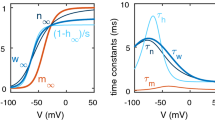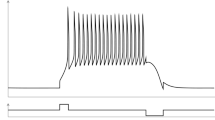Abstract
Spatiotemporal patterns of action potentials are considered to be closely related to information processing in the brain. Auto-generating neurons contributing to these processing tasks are known to cause multifractal behavior in the inter-spike intervals of the output action potentials. In this paper we define a novel relationship between this multifractality and the adaptive Nernst equilibrium in hippocampal neurons. Using this relationship we are able to differentiate between various drugs at varying dosages. Conventional methods limit their ability to account for cellular charge depletion by not including these adaptive Nernst equilibria. Our results provide a new theoretical approach for measuring the effects which drugs have on single-cell dynamics.






Similar content being viewed by others
References
Aslanidi, O., & Mornev, O. (1999). Soliton-like regimes and excitation pulse reflection (echo) in homogeneous cardiac purkinje fibers: results of numerical simulations. Journal of Biological Physics, 25, 149–164.
Barabasi, A., & Vicsek, T. (1991). Multifractality of self-affine fractals. Physical Review A, 44, 2730–2733.
Chamberland, S., & Topolnik, L. (2012). Inhibitory control of hippocampal inhibitory neurons. Frontiers in Neuroscience, 6(165).
Commins, S., Gigg, J., Anderson, M., & O’Mara, S. (1998). The projection from hippocampal ca1 to the subiculum sustains long-term potentiation. Neuroreport, 9, 847–50.
Cressman, J., Ullah, G., Ziburkus, J., Schiff, S., & Barreto, E. (2009). The influence of sodium and potassium dynamics on excitability, seizures, and the stability of persistent states: i. single neuron dynamics. Journal of Computational Neuroscience, 26(2), 159–170.
Cressman, J., Ullah, G., Ziburkus, J., Schiff, S., & Barreto, E. (2011). Erratum to: the influence of sodium and potassium dynamics on excitability, seizures, and the stability of persistent states: I. single neuron dynamics. Journal of Computational Neuroscience, 30, 781.
Ermentrout, B. (1996). Type 1 membranes, phase resetting curves, and synchrony. Neural Computation, 8, 979–1001.
Ermentrout, B., Pascal, M., & Gutkin, B. (2001). The effects of spike frequency adaptation and negative feedback on the synchronization of neural oscillators. Neural Computation, 13, 1285– 1310.
Fadda, P., Robinson, L., Fratta, W., Pertwee, R.G., & Riedel, G. (2004). Differential effects of thc- or cbd-rich cannabis extracts on working memory in rats. Journal of Neuropharmacology, 47, 1170–1179.
Fetterhoff, D., Opris, I., Simpson, S.L., Deadwyler, S.A., Hampson, R.E., & Kraft, R.A. (2014). Multifractal analysis of information processing in hippocampal neural ensembles during working memory under thc administration. Journal of Neuroscience Methods, 1, 1–18.
Forrest, M.D. (2014). Intracellular calcium dynamics permit a purkinje neuron model to perform toggle and gain computations upon its inputs. Frontiers in Computational Neuroscience, 8, 86.
Hodgkin, A. (1948). The local electric changes associated with repetitive action in a non-medullated axon. Journal of Physiology, 107, 165–181.
Hodgkin, A.L., & Huxley, A.F. (1952). A quantitative description of membrane current and its application to conduction and excitation in nerve. Journal of Physiology, 117, 500–544.
Hoppensteadt, F., & Izhikevich, E. (1997). Weakly connected neural networks. New York: Springer.
Ihlen, E.A.F. (2012). Introduction to multifractal detrended fluctuation analysis in matlab. Frontiers in Physiology, 3, 1–18.
Izhikevich, E.M. (2010). Dynamical systems in neuroscience: the geometry of excitability and bursting. Cambridge: The MIT Press.
Kantelhardt, J.W., Zschiegner, S.A., Koscielny-Bunde, E., Bunde, A., Havlin, S., & Stanley, E.H. (2002). Multifractal detrended fluctuation analysis of nonstationary time series. Physica A, 316(141).
Kobayashi, R., & Kitano, K. (2016). Impact of slow k + currents on spike generation can be described by an adaptive threshold model. Journal of Computational Neuroscience, 40, 347–362.
Koch, C., & Segev, I. (1989). Methods in neuronal modelling: from synapses to networks. Cambridge: The MIT Press.
Krinskii, V.I., & Kokoz, Y.M. (1973). Analysis of equations of excitable membranes - i. reduction of the hodgkin-huxley equations to a second order system. Biofizika, 18, 506–511.
Meier, S.R., Lancaster, J.L., & Starobin, J.M. (2015). Bursting regimes in a reaction-diffusion system with action potential-dependent equilibrium. PLoS ONE, 10, e0122401.
Noori, H. (2011). The impact of the glial spatial buffering on the k + nernst potential. Cognitive Neurodynamics, 5, 285–291.
Pinsky, P.F., & Rinzel, J. (1994). Intrinsic and network rhythmogenesis in a reduced traub model for ca3 neurons. Journal of Computational Neuroscience, 1, 39–60.
Pinsky, P.F., & Rinzel, J. (1995). Erratum to: intrinsic and network rhythmogenesis in a reduced traub model for ca3 neurons. Journal of Computational Neuroscience, 2, 275.
Qian, B., & Rasheed, K. (2004). Hurst exponent and financial market predictability. In Financial engineering and applications (FEA 2004), Proceedings of the IASTED international conference (pp. 203–204).
Schwalger, T., & Lindner, B. (2013). Patterns of interval correlations in neural oscillators with adaptation. Frontiers in Computational Neuroscience, 7(164).
Scoville, W., & Milner, B. (1957). Loss of recent memory after bilateral hippocampal lesions. Journal of Neurology Neurosurgery and Psychiatry, 20, 11–21.
Traub, R.D., Wong, R.K.S., Miles, R., & Michelson, H. (1991). A model of a ca3 hippocampal pyramidal neuron incorporating voltage-clamp data on intrinsic conductances. Journal of Neurophysiology, 66, 635–650.
van Vreeswijk, C., & Hansel, D. (2001). Patterns of synchrony in neural networks with spike adaptation. Neural Computational, 5, 959–992.
Williams, R., & Herrup, K. (1988). The control of neuron number. Annual Review Neuroscience, 11, 423–453.
Author information
Authors and Affiliations
Corresponding author
Ethics declarations
Conflict of interests
The authors declare that they have no conflict of interest.
Additional information
Action Editor: Frances K. Skinner
Rights and permissions
About this article
Cite this article
Meier, S.R., Lancaster, J.L., Fetterhoff, D. et al. The relationship between nernst equilibrium variability and the multifractality of interspike intervals in the hippocampus. J Comput Neurosci 42, 167–175 (2017). https://doi.org/10.1007/s10827-016-0633-5
Received:
Revised:
Accepted:
Published:
Issue Date:
DOI: https://doi.org/10.1007/s10827-016-0633-5




